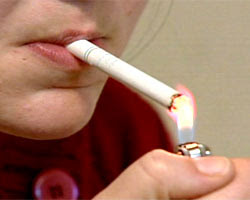Discovering when and why students smoke might lead to the development of better intervention methods, according to researchers at the University of Missouri. In an article published in the journal Substance Use & Misuse, the researchers showed that partying, drinking and work prompted college students to recall their smoking experience, and that smoking occurred most often at the start of the semester and on weekends.
"Students are using social events and work as cues to remind them about smoking," said Nikole Cronk, PhD, assistant professor of family and community medicine at MU and lead author of the article. "This research is important for those working with college students to recognize when smoking is happening at its highest levels. Targeting interventions during those periods and prior to frequent smoking events would have the maximum impact on student smoking prevention."
Nearly a half million deaths are attributed to smoking annually, costing nearly $200 billion in health care costs and lost productivity in the United States. Though cigarette smoking remains the leading cause of preventable deaths in the country, more than 20 percent of the population smokes. Every day, another 1,000 young people become new smokers.
"We know that college is a time where we see initiation of smoking," Cronk said. "If you ask college students, many will tell you it's something they don't intend to do after they're out of school, but a significant number do continue smoking. What we know is there's no safe level of smoking and no way to know that once you start you'll be able to easily quit."
Among college students, the rate of reported smokers spikes to nearly 30 percent. Since research shows that the majority of lifelong smokers begin smoking before the age of 24, targeting college student smokers with intervention and prevention efforts might help reduce those figures dramatically.
"In our study, smoking rates were higher at the start of the semester and on weekends," Cronk said. "Targeting smoking prevention efforts immediately after students arrive on campus and throughout the semester in student email messages just prior to the weekend would be the most effective times to reach students."
Partying, work, drinking, fraternity and sorority events, and vacation were among the top cues for recall of past smoking among students in social fraternities and sororities who participated in the study from 2006 to 2008. MU researchers believe their study is the first to examine smoking habits among this population.
Cronk's study is part of a larger research project published in Preventive Medicine. The project focuses on a behavioral intervention approach known as motivational interviewing. In the approach, a clinician interviews a participant to discover what's important to that individual and how a behavior, such as smoking, might fit with that person's goals and values. Opposed to a traditional intervention approach that tells participants how to behave, motivational interviewing elicits motivation from participants to help them decide on their own whether to continue a behavior.
"The key for intervention using that approach is identifying an individual's motivation for smoking," Cronk said. "Helping people understand why they are engaging in a behavior has much more promise for getting that person to address a behavior."
Source: University of Missouri [November 06, 2011]





 Posted in:
Posted in: 








0 comments:
Post a Comment